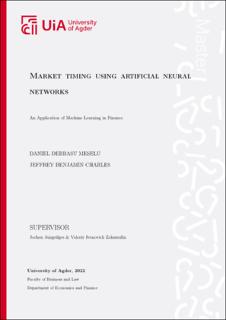| dc.contributor.advisor | Jungeilges, Jochen | |
| dc.contributor.advisor | Zakamulin, Valeriy Ivanovich | |
| dc.contributor.author | Meselu, Daniel Debbasu | |
| dc.contributor.author | Charles, Jeffrey Benjamin | |
| dc.date.accessioned | 2022-08-13T16:23:20Z | |
| dc.date.available | 2022-08-13T16:23:20Z | |
| dc.date.issued | 2022 | |
| dc.identifier | no.uia:inspera:110159342:9802104 | |
| dc.identifier.uri | https://hdl.handle.net/11250/3011712 | |
| dc.description.abstract | The emergence of artificial neural networks has given us some of the most impressive technological tools. Inspired by the human brain, these networks consist of interconnected artificial neurons that can detect patterns invisible to the human eye. These qualities have caught the attention of investors seeking ways to beat the market. In this thesis, we explore how artificial neural networks can be used to construct an active trading strategy and evaluate the strategy's performance against two benchmark strategies. Two stock indices were used to train neural networks using the lagged return as input to predict the market state. By using the networks' predictions, an active trading strategy was constructed. To evaluate the network-based strategy, we test if the Sharpe ratio differs significantly from the Sharpe ratio of a simple moving average strategy and the buy and hold strategy. Additionally, we estimate the alpha in the capital asset pricing model. The results show that the network strategy performs similar to the benchmark strategies in terms of Sharpe ratio and fails to generate significant alphas. Overall, our results contribute to the previous literature seeking to apply neural networks to finance and should serve as a reminder of the shortcoming of financial data for machine learning and the importance of statistical testing. | |
| dc.description.abstract | | |
| dc.language | | |
| dc.publisher | University of Agder | |
| dc.title | Market Timing Using Artificial Neural Networks | |
| dc.type | Master thesis | |
